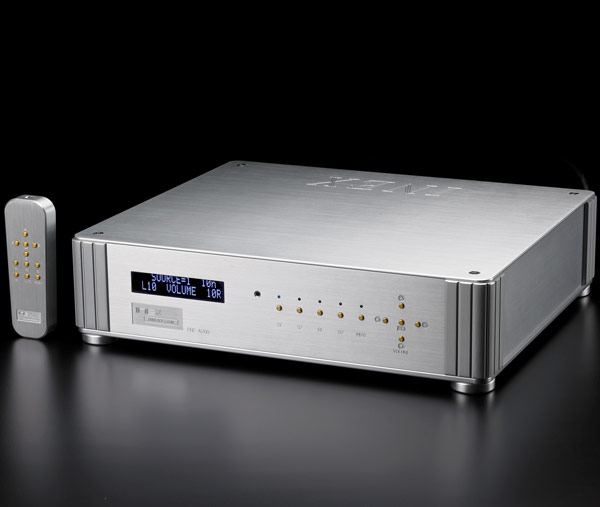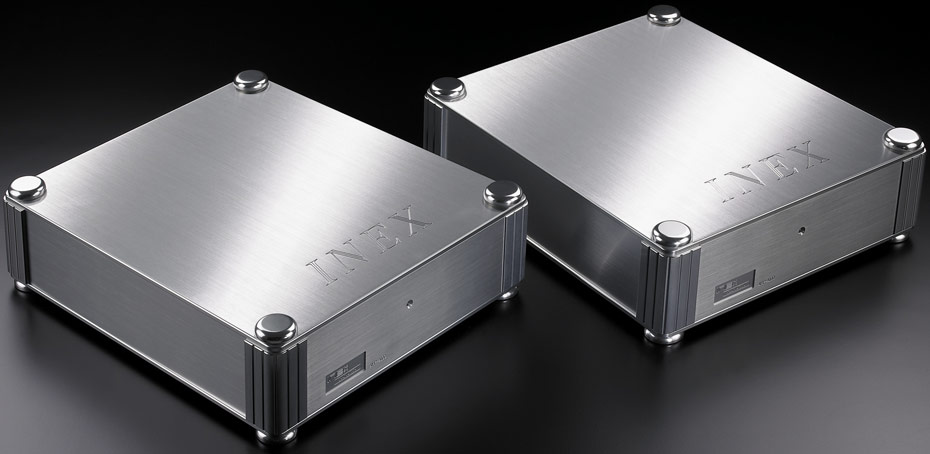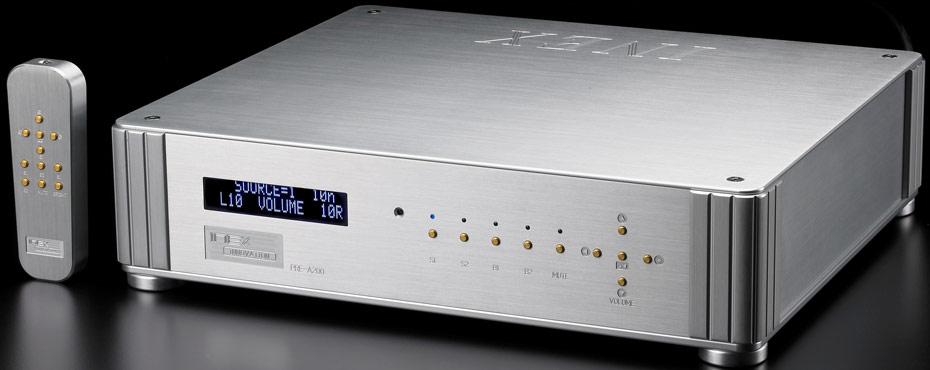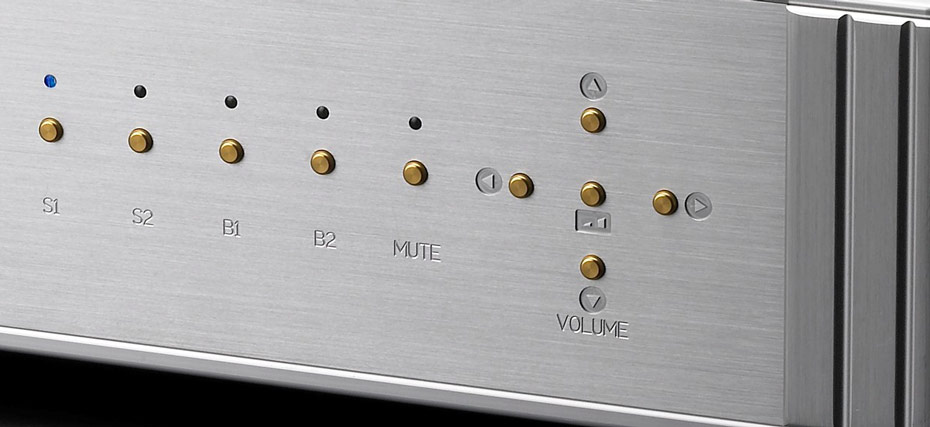It happens in the blink of an eye, in a flash, at the speed of light – the signal is sent, the music plays, and the ears are awash in waves of sound. The soul is stirred, and the mind feels… Free? Empowered? Thrilled?
What is it like to hear sound conveyed at the speed of light? While that may be difficult to report in terms of natural phenomena, I can report what signals sped through optic channels sound like. In this article we will trip the light fantastic, by investigating light-linked, nimble-toed components by INEX Innovation.
Shedding Some Light On The Subject
INEX stands for Into the NEXt generation, the company being composed principally of Jimmy and Mitch Ko, Sean Tan and Kevin Tseng, all with engineering backgrounds and strong ties in the development of fiber optic technologies. The vision held by these men is for fiber optic cables to replace wires in all signal transmission, including high-end audio applications. The advantages of fiber are in its nature of rejecting EMI and RFI, unidirectional transmission breaking ground connection which yielding a perfect, dark sonic background, and light-speed transmission for all signals to arrive at the receiver simultaneously.
Consequently, INEX Innovation products treat all audio signals fully in the analogue domain, then convert electrical signals to light, then back once again. A swap is being conducted, photons for electrons, which INEX believes yields a truer musical result. At one point in my interview with INEX I was told, “All INEX Photon products have never transferred the audio signals to digital formats after the signals [sic] out of the audio sources. We keep all sound paths in the truest analogue domain. This is true even for the Photon Digital Cable.” According to INEX, all A/D and D/A conversions cut off some of the original sample and the details are lost after the transfer. INEX felt theirs was a more elegant way to handle the signal. There has been some confusion on this point. Audiogon’s 2011 CES show report claimed (it may be corrected at some point) that INEX indicated their system uses no digital conversion in their CD player. This player does have a DAC as the nature of the beast. However, once that conversion has been attained the signal remains analogue either optically or electrically from source to speaker.
According to INEX their Photon products, “change the signals between electrical and optical formats to fit in different transmission media… we take the electrons coming in, analogue or digital domain being irrelevant, and map it directly to the same ration of photon and send it down the path and convert it back.” If I understand correctly, then INEX is linking the frequency of the sampling to the frequency of the light. As the digits of a Redbook player are quantified, so also the frequency of light would capture the precise value of the bits read from the player. The rapid reading of the light stream would produce the map of the sonic equivalent of a digital stream.
If this is so, then the quality of the sound would be related to the quality of the fiber optic gear – INEX uses glass fiber, not a form of plastic – reading the bits at the disc, transmitting the light frequencies via the cables, and reassembling the signal at the amp. In theory it seems to me that it would work, considering the amazing rates at which discs are sampled and converted digitally. Why not sample light frequencies in a similar fashion to avoid the quantization errors?
The concept does seem to have merit logically, and there does seem to be an inky black background when using INEX products. What’s strange is that the intensity of the light in the fiber optic channel of the interconnects and digital cable, as well as the quality of DC power sent to them, seems to influence the result audibly! We will hear more about that later.
The Measure of A Photon
The four sizable boxes of INEX gear arrived well packed with minimal instructions. I was instructed to refer to the website, where busy illustrations of systems utilizing multiple powered components and cables were portrayed. There was no manual online for the monoblock amplifier. It took a few emails to INEX to get the system layout ready, as it is not entirely intuitive to me. INEX needs to fix this problem immediately, as people with less technical savvy than me will throw up their hands in despair at seeing such an array of devices. If INEX wants these cables to become the standard, they need to standardize installation, making it much clearer to the user. Perhaps a color coded termination system would be helpful, the way computers use different colored jacks to assist with assembly of the computer. We audiophiles typically use red and black; INEX could do with a couple more colors for all the extra wiring and power supplies involved.
First, let’s admire the smooth, polished aluminum casework of the Photon series components, starting with the Photon A200 preamp. On the left side of the brushed face of the preamp resides the rather simple digital display, with industrial appearing LED characters. One can see that the perfect melding of art and industry is not yet in place at INEX; there is a bit of a feel that the components would be at home in a lab rather than an audiophile’s room. Especially since the blue LEDs on the amplifier are eye-scorchers. Even in a well lit room at eye level they are piercingly bright. Fortunately, the brightness level can be adjusted via remote.
The display is split with the left channel pushed to the outer left edge and the right channel at the opposite extreme, both having their own digital indicator of level from 0-100. Centered in the display is the variable volume control indicator, allowing for stepped increments of 1, 5 or 10 units. The corresponding controls for this are found on the opposite side of the front panel in a cross shaped formation, the VOLUME buttons top and bottom, the BALANCE buttons left and right of the centered unit control button. The full control set is also found on the remote with similar arrangement physically. The remote is minimalist, with enough buttons to control all functions and is hewn in rugged aluminum, but is not backlit. There is a very narrow window of operation with the remote. If the components are at floor level you will find yourself reaching down to issue commands; keep the components up high on a rack directly ahead and you should be fine. One should be able to memorize the functions and use them in dim light by feel. One can adjust the balance and level of each channel independently. It took a while for me to get used to the ability to vary the volume units used to change output level; many times I found myself cycling the units indicator instead of actually varying the level. However, once I got the hang of it, jumping by a multiple of five or ten was nifty, as it saved effort. The accompanying electronic ‘beep’ at every push of the volume control was similarly annoying at first, but became part of the rig after several days. Similar to the gatling gun sound of the Cambridge Audio Azur 840E preamplifier’s stepped attenuator, the noise associated with the component became less critical as time went on, and by the time I had lived with the unit a while it was a non-issue. The beep ramps up in level to pace the system’s output, so that it never is overwhelmed by the music.
If INEX really wanted to make this feature more useful they might perhaps correlate the pitch of the beeping to the multiple of the volume increase/decrease. That way the audiophile could tell instantly by listening what the settings were on the volume control. The display is too small to see easily with my nearly 50-year-old eyes unaided by glasses, so the variable pitch of the volume control would come in handy. If a component is going to beep when the volume changes, it may as well convey as much information as possible.
Also seen on the front to the right of the display is the IR sensor, four INPUT Indicators (two for single-ended and two for balanced) and the indicator for the MUTE function. The preamp starts on MUTE with the left and right channels zeroed out. Oddly, at one point I tried muting the Photon and swapping a Photon Interconnect for a Photon Digital Cable, as I do on some more traditional systems to hear if there would be a change to the sound. When I conducted the switch of the cables, even though the unit was on zero volume there was slight sound emanating from the speakers. After cycling the unit on and off a couple times the seepage from the volume control ceased. Perhaps this had something to do with the fact that the volume control is managed in the optic realm as well.
On the rear of the Preamplifier are the anticipated POWER switch and 15A IEC receptacle to the left, a pair of single-ended inputs (marked S1 and S2), pair of balanced Inputs (B1 and B2), and the complementary pairs of single ended and balanced outputs. I ran into another mystery when attempting to connect the Monoblock amplifiers as there was no indication on the rear of the preamp as to which inputs would coordinate with the outputs. I was told that either would do; the amp is balanced and one can use either set with whichever input is selected. This also needs to be highlighted in the Manual/Directions.
Starting up the Photon Preamp was surprising as I heard what sounded like a small motor making adjustments. Upon inquiry I learned that this was the optic volume control setting itself. Now it had become clear why the volume control was messed up when I muted the system and swapped cables. Resetting the system solved that problem.
The Photon Monoblock Power Amp is a straightforward deal. It has complementary chassis design to the Photon preamp, and they look like a space age class act together. Only the blue LED interrupts the smoothness of the façade, and the back is uncluttered, having besides the power cord receptacle the single ended and balanced inputs, as well as the power ports for the amp end terminations of the Photon Amp Cables (no i-Pure DC unit is required at the amp end).
- (Page 1 of 2)
- Next page →




I Love my Inex Preamp ! I use it with my fantastic Audio Power Labs Class A Tube amplifiers the TNT 50 and the TNT833 ! I got 10 of these Faberge Monos !